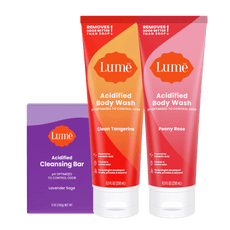
Stop Tolerating Problem Ingredients in Your Deodorant
by Shannon Klingman, M.D.
Besides the chemicals, deodorants on the market today leave a lot to be desired, yet, we tolerate them.
Why?
What are you tolerating from your deodorant?
- Ineffective odor control
- Stains on your clothes
- Discoloration of your skin
- Rashes or burns
- B.O. slicks on the pits of your shirts
- It makes you wonder who thought up deodorant in the first place…
In the caveman days when “survival of the fittest” meant avoiding carnivores and cannibals, we needed body odor to keep us from becoming lunch. It was to our advantage to have body odor.
Nowadays? Not so much.
As humans, we’ve been trying to get rid of body odor for thousands of years.
We can go all the way back to the ancient Egyptians who wore scented wax cones on their heads. The wax melted in the heat of the day and dripped down their bodies, releasing the lovely scents of incense and herbs.
Imagine how tough that was to get out of your hair!
The Greeks and Romans dipped their bodies in perfumes. They also offered the same opportunity to their guests.
You can imagine this wasn’t just a nice gift for their guests – no one wanted to hang out with people who smelled bad!
Once we began to have access to the luxury of running water and bathing facilities, this cut down on the spread of disease and also reduced human body odor… sort of. I don’t know about you, but after a shower, I’m only odor-free for about 45 minutes, unless I use some sort of deodorant.
During colonial times, baking soda became known as a cleaning agent and was used to control body odors.
It worked great…said no one ever!
It is a mild abrasive and I personally use it in my home to clean sinks and whiten my teeth. I began using it in my kitty litter box last year, too!
The origins of today’s deodorants
Then, in 1888, Mum was patented and marketed as the first deodorant for underarm use. Its active ingredient was zinc oxide, which was minimally effective at inhibiting the growth of bacteria.
Everdry, the first aluminum-containing antiperspirant, was released in 1903. It contained the ingredient aluminum chloride. It stung and was capable of eating through clothing.
The rise of ineffective natural deodorants
Then somehow recently, despite its many drawbacks, baking soda gained popularity in the market of natural deodorants over the last 5-7 years.
Did you know that baking soda, when used as a “leave-on” product for your skin, may cause a rash? It is the #1 irritant in natural deodorant today and is not dermatologist-recommended. It can also discolor your skin and clothing while controlling body odor for single-digit hours at best.
And, oh! The grease marks! I ruined so many articles of clothing trying out natural deodorants and still can’t get the B.O. residue out. I guess they worked better than using nothing at all…?
People tolerated baking soda as being ineffective or giving them a rash in order to avoid aluminum.
What about the salt crystal?
Another alternative that has become popular is the salt crystal.
Baking soda does work better than a salt crystal! I think just about anything does. If a salt crystal works for you, then you have no B.O. to begin with. It is that ineffective. I wish I was one of those people with no B.O., swiping a salt crystal under my pits like a superhuman …but then again, Lume wouldn’t have made it on the scene for all of us varsity stinkers out there!
Stop tolerating problem ingredients in your deodorant
Antiperspirants with baking soda, waxy ingredients, and fragrance oils – these are all problem ingredients you don’t have to put up with anymore.
Some natural deodorants now use magnesium hydroxide to avoid the bad side effects of baking soda. While this can help avoid rashes, it’s not as effective as baking soda.
There are also odor-absorbing charcoal deodorants saturated with butters and waxes… Well, let’s just say oil and water don’t mix, so they’re not great at absorbing moisture, either.
Over 100 years after the first underarms deodorant came out, this was still the best we could do…until Lume Deodorant for Pits, Privates & Beyond!
Finally, some much needed innovation in human hygiene
When I set out to create Lume Deodorant, I originally developed it for my patients with concerns about odor below the belt. As you know, that can be a sensitive area, and there was no way I was going to use harsh ingredients like baking soda.
I also wanted to make sure this skin-safe deodorant was water-based so it would not leave any residue behind on your clothing or skin.
There was nothing like this on the market. I had no predetermined path to follow. I had to think outside the box and come up with something completely new.
That’s why our formula is different than anything else on the market, and we actually have two patents!
For all the same revolutionary odor-controlling active ingredients as Lume Deodorant, try Lume Acidified Deodorant Wipes. Most deodorant wipes on the market are simply wet wipes, even if they’re marked with a deodorant brand name. Lume Wipes can do so much more for you than a wet wipe because they also offer lasting deodorant protection—they're clinically proven to control odor for 24 hours.
So if you haven’t given Lume a try yet, what are you waiting for?
Recent Articles
- Feminine Hygiene Myths: A Tale As Old As Time
March 24, 2025
- Do Showers Control Body Odor?
March 18, 2025
- The Skin Loving Benefits of Mandelic Acid
February 28, 2025
- Why Is Acid In My Deodorant?
February 28, 2025
- What Are AHAs?
February 28, 2025
- 3 Helpful Tips For Getting Started
February 28, 2025
- Unlocking Smoother Looking Skin: Lume's Guide to Managing KP
January 29, 2025
- Drier Days Are In Your Pits’ Future!
January 15, 2025
- This Spray Slays
January 10, 2025
- The Best Underboob Sweat Remedy
January 10, 2025
















